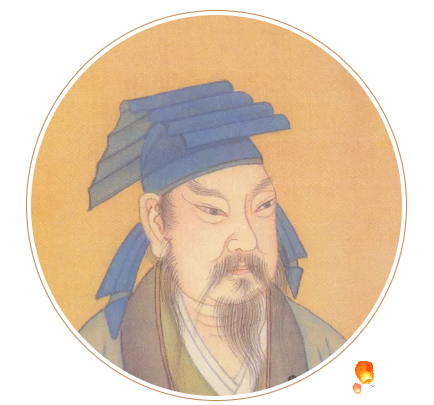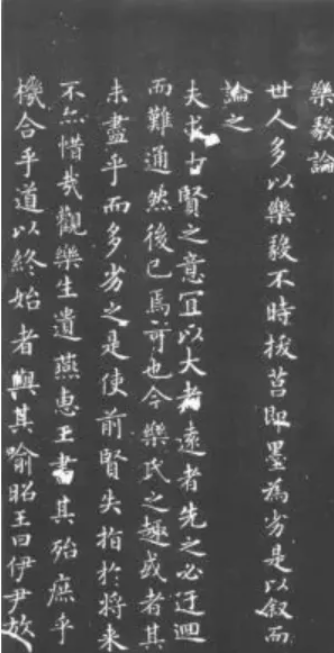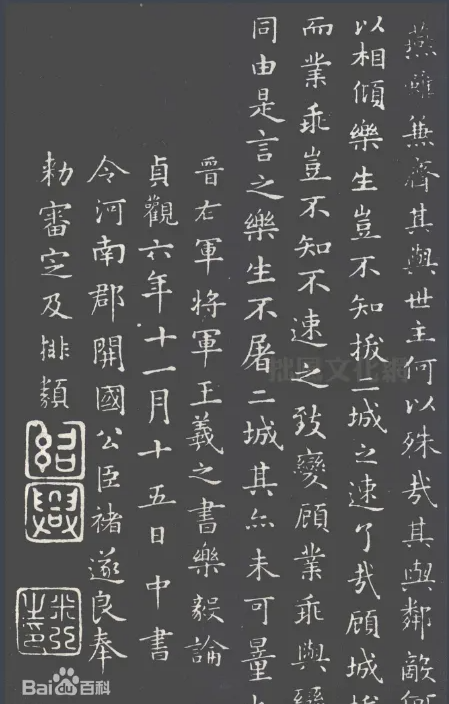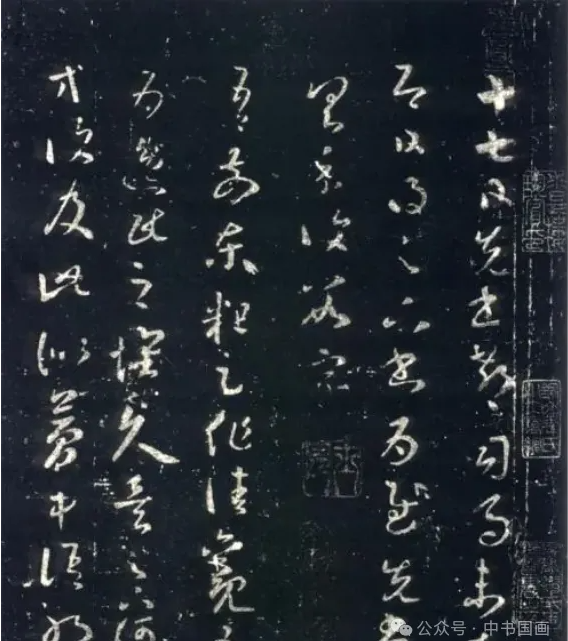| 一支妙笔东晋来 留的矜墨百世香 |
| 日期:2024/03/23 09:29:27 | 类别:1 | 来源: 中国书画网 |
[提要] |
|
王羲之(321年-379年或303年-361年),字逸少,世称王右军。琅邪(今山东省临沂市)人,后移居会稽山阴(今浙江省绍兴市)。东晋时期大臣、文学家、书法家。淮南太守王旷之子。 Wang Xizhi, known by his courtesy name Yishao and also renowned as the General of the Right, was born in the year 321 or 303 and passed away in 379 or 361. A native of Langya (present-day Linyi City, Shandong Province), he later moved to Shanyin in Kuaiji (now Shaoxing City, Zhejiang Province). During the Eastern Jin Dynasty, he distinguished himself as a minister, a literary figure, and a calligrapher. The son of Wang Kuang, the Governor of Huainan. 王羲之一生笔墨功成,隶、草、楷、行四体俱佳,研体势之精,追手心之摹,采众家之长,精诸体之备,冶之于一炉。其书用笔之细腻,结构之多变,脱汉魏而自成一体,影响深远。书法平和而自然,笔势委婉而含蓄,遒美健秀。故命曰:王右军,笔法超群,兼善隶草及楷行,精研体势,心手相随,广采众长,诸体备精,融汇贯通。其笔之细腻,构之变化,摆脱汉魏,独树一帜,遗风远被。书风平和如自然,笔力温婉含蓄,线条遒劲而美观。 Wang Xizhi, a master of calligraphy, dedicated his life to the perfection of calligraphy. Excelling in the scripts of clerical, cursive, regular, and semi-cursive, he delved into the essence of posture, seamlessly blending thought and motion. He gathered the strengths from various masters, refining a multitude of styles into a single crucible. His calligraphy is characterized by delicate strokes and dynamic structures, breaking free from the Han and Wei dynasties' conventions to establish a unique style that profoundly influenced generations. His art is marked by a harmonious and natural elegance, with gestures both subtle and restrained, lines both strong and beautiful. Hence it is said: Wang the General of the Right, whose penmanship was unparalleled, adept in the four major scripts, meticulously studied form and spirit, heart and hand in harmony, embracing the best of many, mastering all styles with finesse, merging them into unity. His brushwork, precise and ever-changing, transcended the old, creating a legacy of his own. His style, as serene as nature itself, carried a gentle force, concealing power within grace, drawing lines of vigorous beauty. 《兰亭序》 Orchid Pavilion Preface 晋永和九年春三月,会稽内史王羲之,携友谢安、孙绰等四十一人,游于会稽山阴兰亭之侧。时芳草鲜美,落英缤纷,众人或坐或立,酌酒赋诗,以流觞曲水之仪相娱。羲之感时光易逝,兴感而发,遂辑诸诗为集,亲撰序文,记流觞曲水之事,抒己之所感,名曰《兰亭集序》。后世誉之“天下第一行书”,亦称《临河序》、《禊帖》、《三月三日兰亭诗序》。 In the spring of the ninth year of Yonghe during the Jin Dynasty, Wang Xizhi, then the Prefect of Kuaiji, journeyed with friends including Xie An and Sun Chuo, among forty-one companions, to the serene Lan Ting (Orchid Pavilion) at the foot of Mount Kuaiji. Amidst the vibrant verdure and scattered blossoms, the assembly, some seated and some standing, indulged in wine and poetry, delighting in the ritual of floating cups along a winding stream. Moved by the fleeting nature of time, Wang Xizhi, inspired, compiled these poems into a collection and authored a preface. This preface, recounting the event and expressing his inner reflections, came to be known as the "Lan Ting Ji Xu," heralded as the "foremost running script under heaven," also referred to as the "Lin He Xu," "Xi Tie," or "Poetry Preface of the Third Day of the Third Month at Lan Ting." 《兰亭序》冯承素摹本(图片来源于网络) 唐太宗重之,亲撰《晋书》中《王羲之传论》,颂其书法“尽善尽美”,临摹本予以贵戚近臣,真迹则以殉葬,以示珍重。是以《兰亭集序》之名,流芳百世,至今犹为世人所仰慕。 Emperor Taizong of the Tang Dynasty esteemed it greatly, personally composing Wang Xizhi's biographical essay in the "Book of Jin," praising his calligraphy as the epitome of perfection. Copies were distributed among the nobility and close courtiers, while the original was buried as a treasure with the dead, signifying its immense value. Thus, the name of "Lan Ting Ji Xu" has been cherished through the ages, still admired by people to this day. 羲之年四十七,书《兰亭序》。其书虽不及行草之札,然以典雅双逸,潇洒时代,莫之能及,亦莫之能侧。布局疏朗而有致,风神挺秀而双逸,笔法变化多端,取势纵横而自如。后之学书者,对之如望城楼之平凡而又神秘,往往难以穷其门径。观其用笔之丰富,藏锋称饰,挂笔回锋,牵丝映带,由方转圆,由圆转方,变幻无穷,横与波挑间或有隶书之遗意,变化莫测,新意迭出。平中见奇,纵中见雅,此《兰亭序》之永恒魅力也。所谓“不激不励,风规自远”者,正是此意。 At the age of forty-seven, Wang Xizhi penned the "Orchid Pavilion Preface." Although in his corpus it may not surpass his cursive and semi-cursive letters in fame, its elegance, dual ease, and the graceful style of its era remain unmatched and unparalleled. The layout is spaciously and purposefully arranged, with a spirit that is both refined and effortlessly elegant. The variability in brushwork and the freedom in composition leave those who study his work feeling as though they are gazing upon a city tower that is both ordinary and enigmatically impenetrable, often finding no way to enter. Observing the richness in his use of the brush reveals concealed sharpness, balanced decoration, returning strokes, drawing threads, reflecting ribbons, transitions from square to round and back again, all manifesting in marvelous transformations. Some horizontal and wave-like strokes carry the legacy of clerical script, unpredictable in their variation, ever renewing with ingenuity. Within the calm, the extraordinary is glimpsed; within the free, the elegant is revealed. This is the eternal charm of the "Orchid Pavilion Preface." It embodies the principle of "neither inciting nor urging, the spirit comes from afar," capturing its essence perfectly. 《兰亭序》此帖虽行书,然其间字体圆润流美,可见东晋楷法之完备,行中隐楷,妍中含骨。南朝楷书虽盛,羲之之传,行草尤胜。比汉魏西晋,其书用笔之细腻,结构之多变,由古拙引至华美精致,转古为秀,美不胜收。《兰亭序》之书风,如珠如璧,与描写之良辰美景,天人合一。羲之“祟山峻岭、茂林修竹”之间,极目所至,乐水乐山。与友人雅集,或悲或喜,抒发情感,叹人生苦短,美景易逝。情景交融,文思泉涌,因天时地利人和,遂留下千古绝唱。后虽欲复此景,然兴未再,笔难逮矣。 The "Orchid Pavilion Preface," although a piece of running script, reveals through its rounded and flowing characters the completeness of Eastern Jin regular script principles, with the essence of regular script concealed within its beauty, and the structure within its charm. Despite the flourishing of regular script in the Southern Dynasties, Wang Xizhi's legacy shines brightest in his running and cursive scripts. Compared to the Han, Wei, and Western Jin dynasties, his calligraphy is noted for its delicate brushwork and variable structure, evolving from the simple and unadorned to a state of refined beauty and elegance, transforming the ancient into the exquisite, an unsurpassable beauty. The style of the "Orchid Pavilion Preface," like pearls and jade, perfectly complements the described moment of beautiful scenery and harmony between man and nature. Amidst "majestic mountains and dense forests, lush groves and tall bamboo," Wang Xizhi found joy in the water and the mountains, gathering with friends in high spirits, sometimes joyful, sometimes sorrowful, expressing emotions, lamenting the brevity of life and the fleeting nature of beautiful scenes. With a blend of scene and sentiment, inspiration flowing freely, the perfect alignment of time, place, and company allowed him to leave behind a masterpiece for the ages. Though he later wished to recreate this scene, the same inspiration never returned, and his pen could not capture it again. 《乐毅论》 The Discourse of Yue Yi 王羲之书《乐毅论》,共四十四行小楷,夏侯玄作。真迹既逝,一云战乱中,咸阳老妪投之灶火,一云唐太宗珍藏。世存刻本甚多,惟《秘阁本》与《越州石氏本》为尤佳。羲之书虽多真迹,唯此帖惟见于石刻。 Wang Xizhi penned "The Discourse of Yue Yi" in forty-four lines of small script, originally authored by Xiahou Xuan. The genuine piece has long vanished, with one account stating it was cast into the flames by an elderly woman in Xianyang amidst chaos, and another claiming it was treasured by Emperor Taizong of the Tang dynasty. Of the many extant engraved editions, the "Secret Chamber Collection" and the "Yue State Shi Family Collection" are esteemed as the finest. Although many authentic works of Wang Xizhi exist, this post survives only in stone inscriptions. 《乐毅论》局部(图片来源于网络) 《乐毅论》局部(图片来源于网络) 《乐毅论》之书,不仅书法艺术颇受推崇,亦于兵法策略有深意。全文用笔刚健有力,线条分明,轻重适宜,点画之间虚实相生,构思严密,为传世小楷之杰作。其风合羲之之洒脱典雅,亦趋唐楷之规矩,被誉为学习小楷之佳范,上乘之作也。 "The Discourse of Yue Yi" is not only celebrated for its calligraphic artistry but also holds profound significance in military strategy. The entire text is characterized by vigorous and strong brushwork, with lines that are appropriately weighted, creating a dynamic interplay between the solidity and void of strokes and marks. The composition is meticulous, regarded as a masterpiece among transmitted works of small script. It blends Wang Xizhi's elegance and freedom with the structured norms of Tang dynasty regular script, esteemed as an exemplary model for studying small script, a work of the highest caliber. 《十七帖》 The Shi Qi Tie 王羲之《十七帖》之作,因卷首“十七”二字而名。原迹既失,今所传皆刻本也。全帖笔法,行行清晰,字字相顾,方圆并用,方中藏圆,折中含转。圆转之际,刚健中蕴婀娜,遒劲内藏婉媚,外示冲融,内涵清刚,简约而不简单,动中有静,字字牵连,主以断续,形虽断而神不断,气势贯通。字形疏密错落,或断或连,如斜而直,风格中和而典雅,平和而不平凡,草书之中,无狂怪之态,显中正之风。此等境界,习草之人,宜深究也。 Wang Xizhi's work, "The Shi Qi Tie," derives its name from the "seventeen" characters at the start of the scroll. The original work has been lost, and what is transmitted today are all engraved editions. The calligraphy throughout the piece is distinct, with each character carefully considered. The use of both square and round strokes, hiding the round within the square and the fold within the turn, reveals a mastery of form and movement. At the point of turning, strength is intertwined with grace, vigor hidden within delicacy. The exterior shows harmony and integration, while the interior embodies clarity and strength. It's simple yet not simplistic, with motion within stillness. Each character is connected, primarily using breaking and continuing, though the form breaks, the spirit carries on, and the momentum is unified. The arrangement of characters in terms of size and density is intentional, creating a pattern of disconnection and connection, akin to being oblique yet straight. The style is balanced and elegant, serene yet not ordinary, devoid of the wild or bizarre tendencies found in some cursive script, displaying a principled and upright style. Such a realm is something that practitioners of cursive script should delve into deeply. 《十七帖》局部(图片来源于网络)
历代名评 Famous Critiques Through the Ages 梁武帝萧衍:“子敬之不迨逸少,犹逸少之不迨元常。”“王羲之书字势雄逸,如龙跳天门,虎卧凤阙,故历代宝之,永以为训。” Emperor Wu of Liang, Xiao Yan, remarked: "Zijing cannot match Yishao, just as Yishao cannot match Yuan Chang." "The character and momentum of Wang Xizhi's calligraphy are bold and unrestrained, like a dragon leaping through the gates of heaven, or a tiger lying at the phoenix's gate. Hence, it has been treasured through the ages and forever serves as a model." 唐太宗:“心慕手追,此人而已,其余区区之类,何足论哉!” Emperor Taizong of Tang said, "To admire with the heart and follow with the hand, this is the man. The rest, mere mediocrities, are hardly worth mentioning!" 孙过庭:“且元常(钟繇)专工于隶书,伯英(张芝)尤精于草体,彼之二美,而逸少兼之。” Sun Guoting stated, "Moreover, Yuan Chang (Zhong Yao) excelled in clerical script, while Boying (Zhang Zhi) was particularly skilled in cursive. The two masters each had their beauty, yet Yishao (Wang Xizhi) encompassed both." |
| 责任编辑:陆地 |
| 注:本站发表的所有文章内容均为作者的观点,不代表中国书画网的立场,更不代表中国书画网的价值判断。 |
| 上一条:书家乔领之“福”照佛心 “福”与众... | 下一条:定主以治家论 |
书画网版权所有 Copyright © 2001-2010 cnshuhua.cn All Rights Reserved 
ICP经营许可证号:京ICP备14028858号-6 ![]() 京公网安备 11010802025726号
京公网安备 11010802025726号
地址:北京市海淀区中关村东路18号1号楼B1608
客服电话:010-68707980 服务咨询QQ:601346133 1203781136
投稿邮箱:601346133@qq.com








